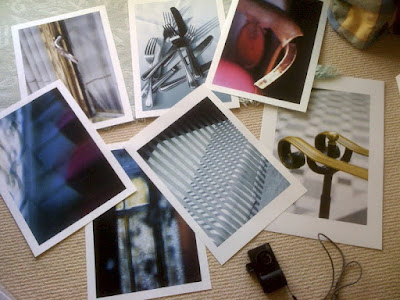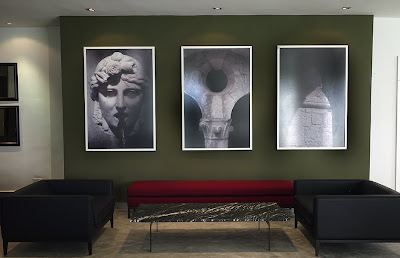I have been meaning to write a piece on photography and how I see it as affecting my life and vision, what photography means to me. Well, I hope this is a start of many more essays I intend to write. Blogs are a great medium to disseminate thought and receive instant feedback, so please feel free to respond, I would love to hear from you, readers.SEEING POETRY IN PHOTOGRAPHY, PART I
The Sun Never Sets : Avoiding cliches in PhotographyWe all do it.
Look through your archive of images over the years and you can surely find many cliche photographs. Defining 'cliche' is perhaps just as important as knowing how to identify these images. Cliche means something that has a common banality, overdone, overstretched, trite and unoriginal. In photography, I am just as guilty as the next person in photographing cliche images.
Photographs like sunsets or sunrise (depending on your personal disposition), waterfalls with extra blurry water, HDR of all varieties, cute babies, even cuter cats and dogs with that 'aww' expression, super sharp macro images of a butterfly perched on a flower with great background 'bokeh', the ubiquitous portrait of a squating ethnic street trader shot from across the street, a three-quarter posing smiling rickshaw driver, a typical Buddhist monk walking to temple in a saffron robe, a smiling Balinese girl in ritual dress balancing a basket of floral offerings on her head, or a wannabe skinny model posing in a bikini with that 'come hither' look in a shopping mall.
We continue to shoot these images for fear of venturing outside the photographic 'comfort zone' that we are so accustomed to because of the apathy of trying.
If you look through your viewfinder and see something familiar, move on, I'd say, its already been done. Only by recognising the unfamiliar, can you then explore its possibilities in fresh compositions and new angles.
That is not to say we cannot learn to see visually by studying images of others. Plagiarism is the greatest form of flattery. Armed with a greater visual acuity in observational skills, a thinking photographer can re-invent the wheel, if needs be, to adopt a new style through the assimilation, transformation and reformulation of ideas. Photography is after all a personal artistic expression of one's visual cortex of what reality is. The camera is only a tool that achieves this expression.
Resist, resist, resist!
By resisting your attempts at photographing cliche, you will begin to look out for the unusual and extraordinary. Photographers willing to seriously step up and out of the mediocrity may need to re-invent themselves, and become artists, as opposed to mere operators. Yasmin Ahmad, who sadly passed away a few weeks ago, mentioned in a TV interview that "there are no creative people, but only good observers". To become artists, I feel that we need to be good observers first.
Observation will lead one to story-telling, and this is where the basis of documentary and journalistic photography takes form. Film-makers are terribly good observers of space and light in the 3-dimensions. Stills photographers can greatly learn from their counterparts how to see through a scene, that is, anticipation of what comes before and after the moment. By looking fluidly through a scene like a movie, the 'decisive moment' (coined by Cartier-Bresson) can be determined in an instance, where eye, mind and camera is working as one in tandem.
To continue photographing cliche imagery is akin to perfecting the perfect. No matter how many attempts in photographing the Eiffel Tower, one can do no better than the picture perfect postcards that depict the structure being sold at the tourist shops. If you are after the perfect image, go buy a postcard.
The Beholder's Eye : Interpreting Photographs © Minnie Mouse and Eiffel, Paris 2002
© Minnie Mouse and Eiffel, Paris 2002
I photographed the image above at the Trocadero in Paris. It was later when I had printed the image then I begin to deconstruct the photograph to its main elements.
The context was that Disneyland Paris was going through a financial bad patch and the French initially saw it's construction as an invasion of Americanism, a 'cultural imperialism' of consumerism. It is as if Monsieur Gustav Eiffel was giving the 'one finger salute' to the Yanks, being represented here as a Minnie Mouse cap-toting child, pretending to be an adult, pushing a pram, with all the insecurities and uncertainties she faces in the future. The whimsical line drawing of the flower on the hoarding adds a humorous twist to the photograph.
I remember actually feeling a bit disappointed as I got to the Trocadero that morning, to see a huge perimeter hoarding around the site, totally obliterating the view of the Eiffel Tower that day due to the renovation project that was going on.
Of course, I had not 'seen' all these elements in the viewfinder at the time of exposure. It was actually a grab shot. The child's parents were probably only steps ahead to the right of the frame. But because I noticed the Minnie Mouse cap first, and thought it had a potential story, I only then framed the child with the hoarding and stepped back a few feet to include the tower in the background. The flower graffiti was purely coincidental.
Approach is everything.
Poetry In Photographs
Why do we make photographs? To answer this question is to understand, not necessarily the process, but social art history. Why do people climb mountains? Because we can.
Similarly, with the invention of the camera lucida, artists were able to draw and thus, paint images with a remarkable likeness to the scene they see, and since the invention of the negative plate and early cameras, creating images and portraits were not only confined to the upper classes and noblemen through commissioning painters. Photography became accessible to the greater public. Men have always been fascinated by the facsimile image of themselves, at work, at play, in social gatherings, and with their families. A photograph records a moment in time, and hence it is immortal, in a skewed sense of the word. It narrows distance, and is nostalgic.
 © Under the Eiffel Tower, 2001
© Under the Eiffel Tower, 2001Why do we photograph? Because we can. In today's throwaway society, we encounter an overkill of images in our daily lives, both in print and electronically. Man have always been image-led. The popularity and growth in digital photography has enabled everyone to make technically decent photographs with little or no knowledge of the processes. Such are the advancements in science, that accessibility to cameras is practically a given. What is lacking however, is the ability to produce meaningful art imagery, where the poetry of a photograph can be read, like a Haiku.
 © Iban fighting cock, Sarawak 2009
© Iban fighting cock, Sarawak 2009Creating a meaningful series of photographs to depict a story can be compared to writing poetry. Writer's block therefore is not uncommon when I photograph. There are good days and bad. Mostly bad as statistically proven. Ansel Adams wrote that he was happy if he could photograph 12 'keepers' a year or so. That may be true for him, working with 10'' x 8'' negatives. Today, a fine art photographer must produce a higher rate of 'keepers' just to keep up with his peers, and competition is rife. There are as many different workflows as there are fine art photographers, so I have surmised that there isn't a right or wrong way, just your way or my way of working.
I prefer working in series, often medium term so as to give ample time for research, execution, fine-tuning and developing the project. Like poetry, my images must first be able to withstand scrutiny, conform to a 'system' of visual cues and can be identifiable as my work.
Next instalment :
Part II :
Visual Signature






.jpg)

